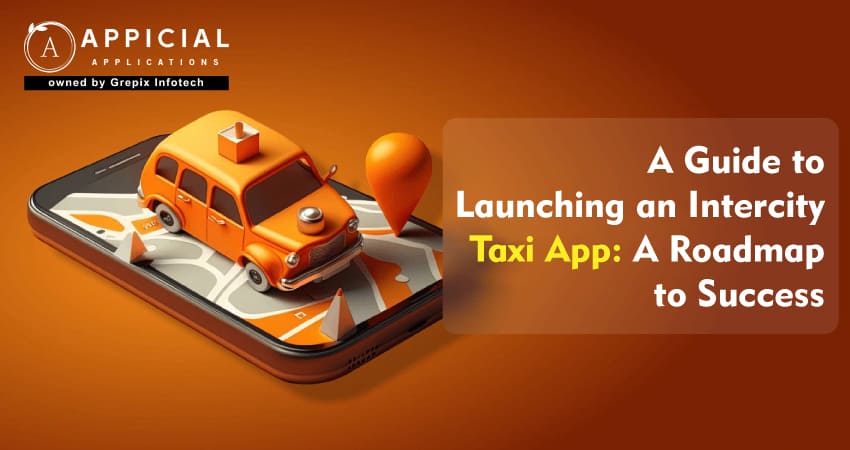
A Guide to Launching an Intercity Taxi App: A Roadmap to Success
Launching an intercity taxi app is more than just creating a platform for booking rides—it’s about revolutionizing long-distance travel with convenience, reliability, and scalability. As cities expand and mobility demands grow, the need for seamless intercity transportation is more pressing than ever. Whether it's connecting major business hubs, tourist destinations, or underserved regions, an intercity taxi app opens the door to untapped market opportunities.
This guide offers a comprehensive roadmap for entrepreneurs, startups, and transport companies looking to venture into the intercity ride-hailing space. From understanding passenger needs and regulatory frameworks to choosing the right tech stack and marketing strategy, every step is crucial to building a successful platform. With competition on the rise and user expectations evolving, your ability to offer affordable fares, real-time tracking, and reliable scheduling will set your app apart.
Let’s explore how to launch an intercity taxi app that drives business growth and customer satisfaction.
Looking to launch a scalable intercity taxi app? This guide offers a complete roadmap from idea validation and market research to development, pricing models, and feature sets. Discover how to overcome challenges like route optimization, driver availability, and dynamic pricing. Learn the essential features your app must have for seamless bookings, real-time tracking, and safety. Plus, explore proven strategies to build, test, and scale your ride-hailing app successfully. Whether you're starting fresh or expanding an existing service, this blog is your blueprint to building a future-ready intercity taxi booking platform.
Launching an Intercity Taxi App: A Roadmap to Success
You wake up in one city. You need to be in another place by noon. No trains are available. Buses are full. Flights? Too much hassle.
What do you do?
You reach for your phone. Tap an app. Book a ride. Sit back. Relax. And let your driver take care of the road. That’s the magic of an intercity taxi app.
A good intercity taxi app solves the real problems travelers face—comfort, reliability, fixed pricing, and ease of taxi booking.
It gives users the freedom to travel when they want, where they want, without relying on outdated systems. The taxi app market size is all set to reach $283 billion by 2028, growing at a 4.2% compound annual rate. (Source: Business Of Apps).
Overview of Intercity Travel
We live in a fast-moving world. People want to travel far, quickly, and comfortably. Whether it’s for work, family visits, or weekend escapes, long-distance rides have become part of everyday life.But here’s the problem—traditional taxis don’t cut it. Intercity buses lack flexibility. Trains aren’t always available or on time. Flights? Too expensive for short hops between nearby cities.
That’s where intercity taxi apps come in. These apps let users book outstation taxis on demand. No lines. No haggling. Just an easy taxi booking and a comfortable ride from City A to City B.It’s a simple idea with huge potential. And if you're planning to launch one, you’re in the right place.
Challenges in Long-Distance Taxi Apps
Before you dive into development, let’s face the roadblocks. Intercity travel is exciting but tricky.
1 Route Optimization
City-to-city travel means higher fuel use, tolls, and longer hours. Your app must plan the best routes to cut costs and time. GPS must be accurate. Any error can cause delays and driver frustration.
2 Dynamic Pricing Issues
A flat rate won’t work. Neither will city fare models. Pricing for long-distance rides depends on kilometers, traffic, route type, and ride duration. Managing this without confusing users is a challenge.
3 Driver Availability
Finding drivers willing to go outstation isn’t easy. They often prefer short rides. You’ll need a reward system or incentives to attract drivers for intercity taxi app bookings.
4 Ride Scheduling and Delays
Not all intercity travel is instant. Some users want to schedule rides in advance. Others may face delays due to weather or personal changes. Your app must handle rescheduling or cancellations smoothly.
5 Safety and Trust
When users book outstation taxi rides, they’ll be with the same driver for hours. That’s a long time to be alone with a stranger. So, safety features like SOS buttons, live tracking, and driver ratings are essential. These challenges aren’t impossible to solve. With the right plan and features, your intercity taxi app can overcome them and lead the market.
Key Features of a Successful Intercity Taxi App
If you want people to choose your app for long-distance rides, it must do more than just work, it should feel effortless.
1 Easy Booking Flow
From choosing pickup and drop locations to selecting car type, the taxi booking process should be smooth. Keep steps minimal and the design clean.
2 Multi-City Ride Support
Support rides not just between two cities but also between towns and rural areas. This widens your audience and boosts demand.
3 Advance Booking & Scheduling
Let users book rides for later. Some may plan trips days in advance. Your app should allow future outstation taxi bookings with clear time slots.
4 Real-Time Fare Estimation
Don’t make users guess. Show exact trip fare, toll charges, waiting fees, and driver allowance before they hit confirm.
5 Multiple Vehicle Options
Offer choices—hatchbacks for budget riders, sedans for comfort, SUVs for families. People love having control over their ride type.
6In-App Navigation and Route Tracking
Use real-time GPS for route suggestions, traffic updates, and ETA predictions. Passengers should see where they are at all times.
7 Live Trip Sharing
A must for safety. Let users share their ride location with friends or family. It builds trust and transparency.
8 Driver Ratings and Reviews
Showcase trusted drivers with high ratings. After every long-distance ride, ask riders to rate and review.
9 Emergency Support
Add an SOS button that connects riders to emergency services or customer support. Include in-trip chat or call features.
10 Payment Flexibility
Accept cards, UPI, wallets, and even cash. Also include fare split options if passengers want to share the ride.
The smoother the app, the higher the bookings. Don’t just launch an app. Launch an experience.
Pricing Models for Intercity Taxi Apps
Money matters. If your pricing isn’t right, people won’t use your app—even if it works perfectly.Let’s break down popular pricing models for intercity taxi apps:
1 Per Kilometer Pricing
This is the most common. Users pay a fixed amount per kilometer. It's simple, but make sure it covers tolls, driver allowance, and fuel costs.
2 Dynamic Pricing
Pricing varies based on demand, route, time of day, and availability. Uber uses this model. It works well, but can confuse users. Clear price breakdowns are a must.
3 Flat Fare Between Cities
Offer flat rates for popular city pairs (like Delhi to Agra or Mumbai to Pune). It makes planning easy and builds user trust.
4 Package Pricing
Offer round-trip or one-way outstation taxi packages. For example, "500 km at ₹10/km with a 12-hour limit." These are great for tourists or business travelers.
5 Subscription or Membership Model
For frequent travelers, offer a subscription plan with discounts, free cancellations, or priority bookings. This builds customer loyalty.
The key is transparency. Users should know what they’re paying for. Hidden charges are a red flag.
Also Read: Step-by-Step Guide to Creating a Taxi App: Transform Your Transportation Business
Launch Plan: Building and Releasing Your App
Launching an intercity taxi app is like starting a journey. You need a map. Here’s your roadmap to launch:
1 Research Your Market
Study your target regions. Who travels where? When do they travel? What do they pay? Use surveys and competitor analysis.
2 Choose the Right Tech Stack
You’ll need mobile apps for Android & iOS, an admin panel, and a driver app. Use scalable technologies that support real-time features.
3 Hire a Development Team
Work with experienced taxi app developers. They’ll help you integrate route mapping, live tracking, and secure payments.
4 Create a Driver Network
Onboard drivers early. Offer joining bonuses, training, and flexible work hours. Highlight the benefits of long-distance rides.
5 Test Everything
Test the app thoroughly before launch. Run simulations, do soft launches in select cities, and fix bugs fast.
6 Marketing and Branding
Promote your taxi booking app through local ads, digital campaigns, and partnerships with hotels or tour agents. Offer discounts for first rides.
7 Go Live
Start small. Choose 2–3 city routes first. Monitor how people respond. Improve based on feedback.
8 Scale Gradually
Once your intercity taxi app performs well on a few routes, expand to more cities. Use data to guide where to go next.
Conclusion
The future of travel is changing. People want more freedom. They want to move between cities on their own time, without stress. A well-built intercity taxi app can make that happen. But to build something powerful, you need the right team behind you.That’s where Appicial Applications comes in.
They don’t just build apps they build smart, scalable, and market-ready taxi solutions. Whether you’re launching your first outstation taxi startup or scaling your existing fleet, Appicial helps you do it faster and better. Their team understands every detail of long-distance rides from fare systems to route planning to driver networks. They’ve already helped dozens of businesses launch high-performing taxi booking platforms around the world.
What makes them stand out? They keep it simple. They stay on time. And they build apps that actually work in the real world.So if you’re serious about launching your own intercity taxi app, don’t start from scratch. Partner with people who know the road and know how to build the engine behind it.
Visit Appicial.com to start your journey today. Your app idea deserves more than just code. It deserves a team that drives it forward.
Looking out to start your own venture like Uber ? Try out our HireMe Taxi Uber Clone, the easiest way to kick-start your taxi business.
Author's Bio

Vinay Jain is the Founder at Grepix Infotech and brings over 12 years of entrepreneurial experience. His focus revolves around software & business development and customer satisfaction.
Back to blog list




